Geological, Mineralogical, Geochemical, and Petrogenetic Characteristics of Plutonic Rocks in Çiftehan (Ulukışla-Niğde) Area, South-Central Türkiye: Implication for Genetic Link with Fe-Zn Skarn Mineralization
Abstract
1. Introduction
2. Geological and Geodynamic Settings
3. Materials and Methods
4. Results
4.1. Geological, Stratigraphic, and Field Relations
4.1.1. Southern Section
4.1.2. Middle Section
4.2. Petrographic Characteristics of Plutonic Rocks
4.2.1. Monzogabbro
4.2.2. Granodiorite
4.2.3. Diorite
4.3. Whole-Rock Geochemical Constraints
4.3.1. Major Element Variation and Rock Classification
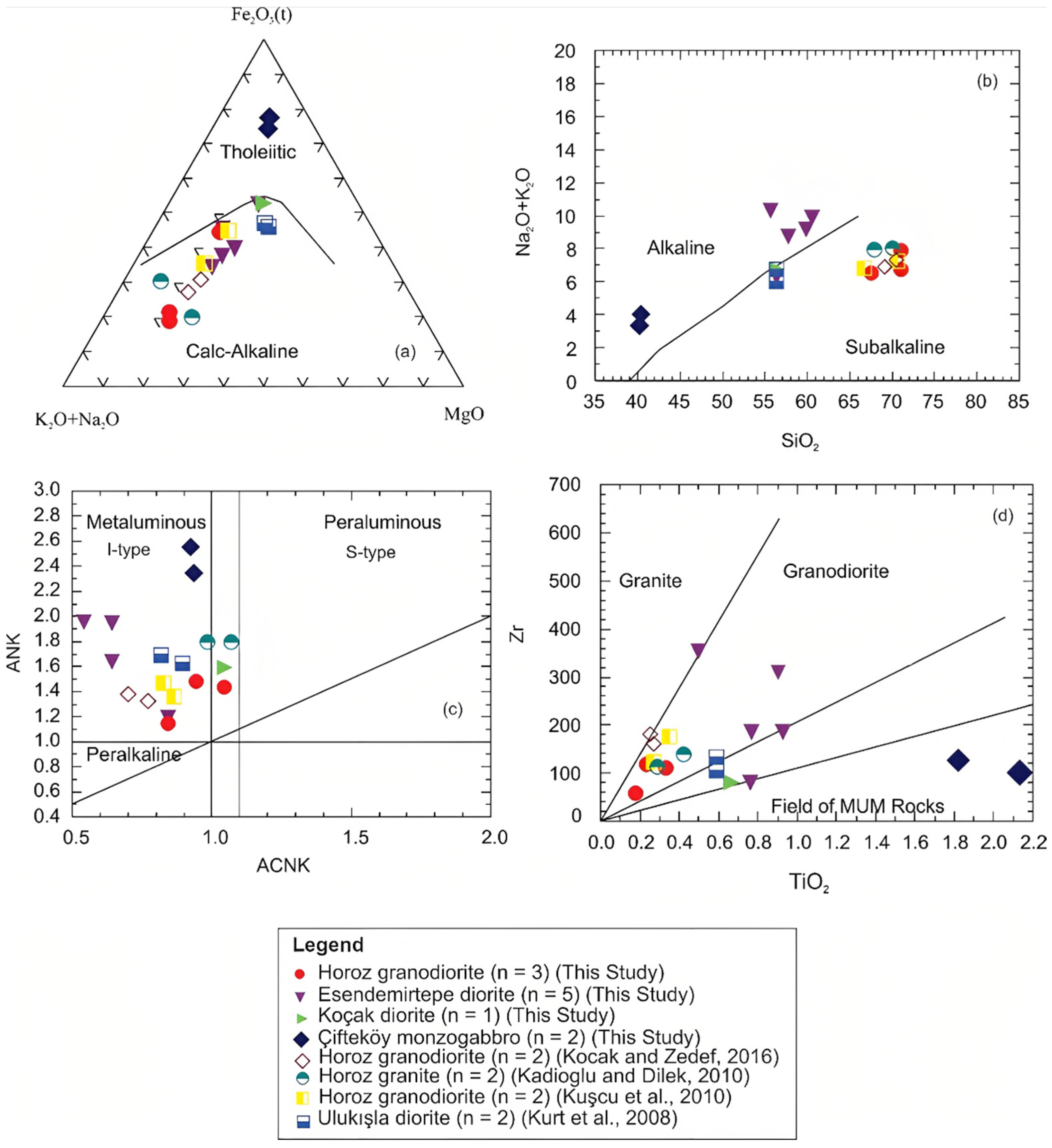
4.3.2. Trace and Rare Earth Element (REE) Variations
4.4. Skarn Occurrences
4.4.1. Esendemirtepe-Koçak Skarn
4.4.2. Horoz Skarn
4.5. Mineralogical Characteristics of the Skarn Deposits
5. Discussion
5.1. Petrogenetic Evolution of the Çiftehan Plutonic Rocks
5.2. Tectonic Environments
5.3. Genetic Link Between Plutonic Rocks and Skarn-Type Formation
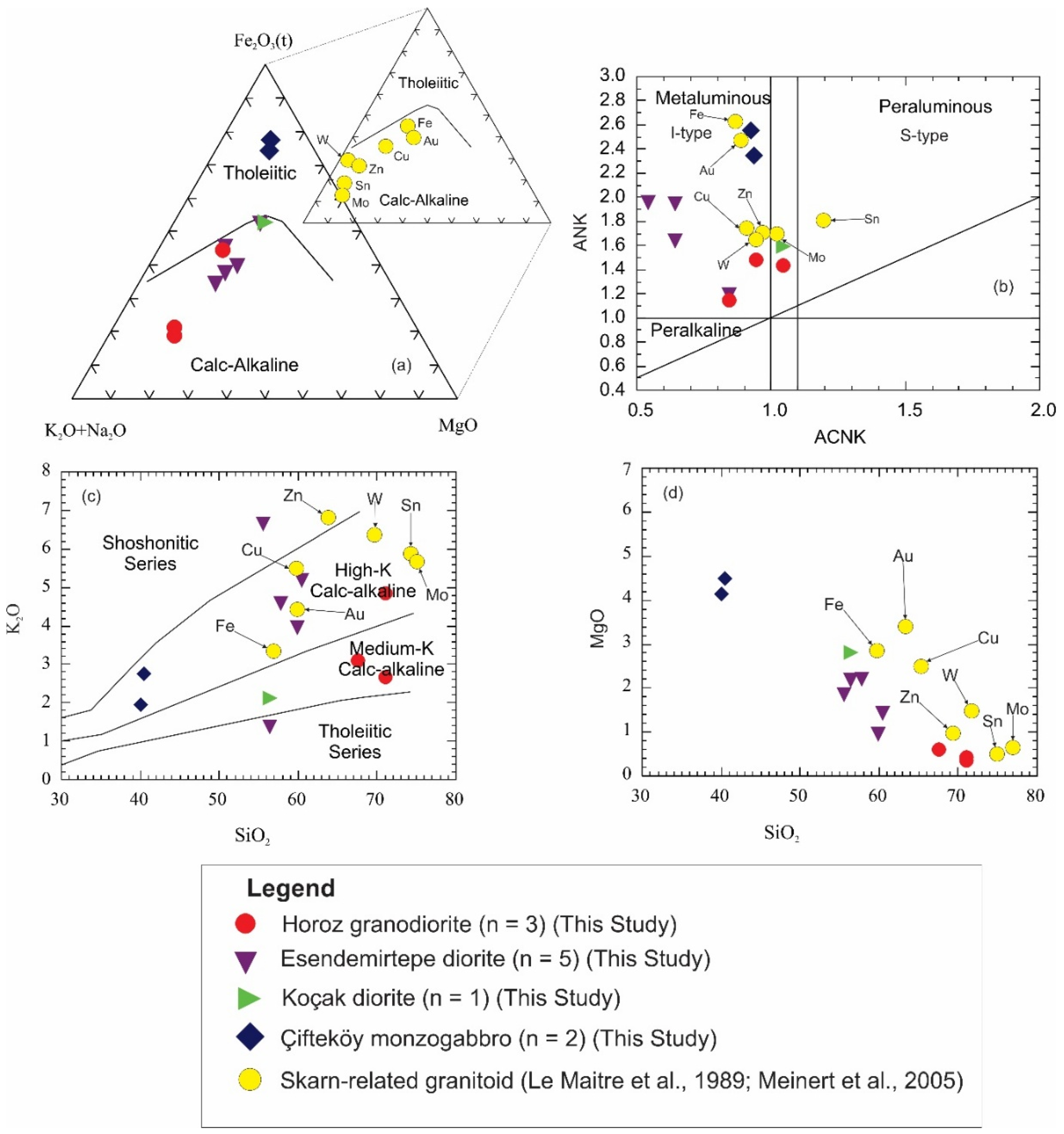
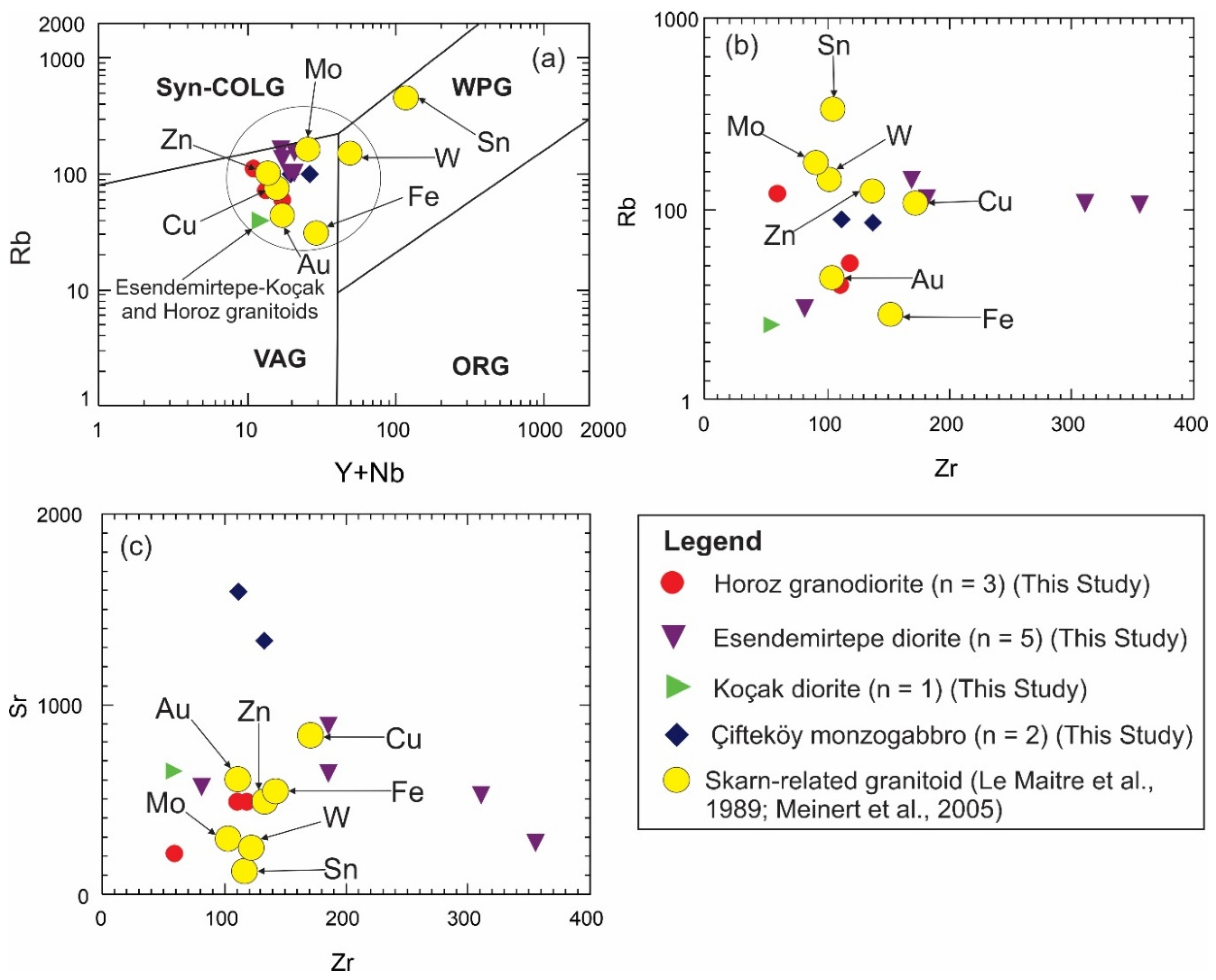
6. Conclusions
Supplementary Materials
Author Contributions
Funding
Data Availability Statement
Acknowledgments
Conflicts of Interest
Abbreviations
| AFM | Total Alkali Iron and Magnesium |
| A/CNK | Alkali/Calcium + Sodium + Potassium |
| CACC | Central Anatolian Crystalline Complex |
| CRD | Carbonate Replacement Deposits |
| HFSEs | High Field Strength Elements |
| HREEs | Heavy Rare Earth Elements |
| ICP-MS | Inductively Coupled Plasma Mass Spectrometry |
| LILEs | Large Ion Lithophile Elements |
| LREEs | Light Rare Earth Elements |
| MREEs | Middle Rare Earth Elements |
| MVT | Mississippi Valley-type Deposits |
| ORG | Ocean Ridge Granite |
| REEs | Rare Earth Elements |
| Syn-COLG | Syn-Collision Granite |
| VAG | Volcanic Arc Granite |
| WPG | Within Plate Granite |
| XRD | X-ray Diffraction |
References
- Kuşcu, İ. Skarns and skarn deposits of Turkey. In Mineral Resources of Turkey; Pirajno, F., Ünlü, T., Dönmez, C., Şahin, M.B., Eds.; Modern Approaches in Solid Earth Sciences; Springer: Cham, Switzerland, 2019; Volume 16, pp. 283–336. [Google Scholar] [CrossRef]
- Çopuroğlu, İ. Mineralogy and Genesis of Zn-Pb Deposits of Yahyalı Kayseri-Demirkazık Niğde-Çamardı Region. Bull. Miner. Res. Explor. 1996, 118, 35–46. [Google Scholar]
- Ayhan, A.; Langeranlı, Y.; Çeltek, N.; Aksoy, E. Study of the Geology of Zn-Pb Deposits in the Aladağlar (West Zamantı) and (Yahyalı-Çamardı) Areas. In Mineral Research and Exploration Report; General Directorate of Mineral Research and Exploration: Ankara, Turkey, 1984. [Google Scholar]
- Çevikbaş, A.; Öztunalı, S. Mineral deposits of Ulukisla-Çamardı basin. J. Geol. Eng. 1991, 39, 22–40. [Google Scholar]
- Temur, S.; Baş, H. Mineralogical and genetic study of iron deposits of the Çiftehan-Koçak (Ulukışla-Niğde) district. Geol. Eng. 1992, 41, 91–103. [Google Scholar]
- Kuşcu, I.; Tosdal, R.M.; Gencalioğlu-Kuşcu, G.; Friedman, R.; Ullrich, T.D. Late Cretaceous to Middle Eocene magmatism and metallogeny of a portion of the Southeastern Anatolian orogenic belt, East-Central Turkey. Econ. Geol. 2013, 108, 641–666. [Google Scholar] [CrossRef]
- Kadioglu, Y.K.; Dilek, Y. Structure and geochemistry of the adakitic Horoz granitoid, Bolkar Mountains, south-central turkey, and its tectonomagmatic evolution. Int. Geol. Rev. 2010, 52, 505–535. [Google Scholar] [CrossRef]
- Kocak, K.; Zedef, V.; Kansun, G. Magma mixing/mingling in the Eocene Horoz (Niğde) granitoids, Central southern Turkey: Evidence from mafic microgranular enclaves. Miner. Petrol. 2011, 103, 149–167. [Google Scholar] [CrossRef]
- Sünger, A.; Akyıldız, M.; Nurlu, N. Significance of the felsic sub–volcanics in development of related Au–Ag deposits at Maden village (Bolkar Mountain region), South Turkey: Constraints from whole–rock geochemistry, geochronology and Pb-S isotopes. Geotectonics 2022, 56, 361–381. [Google Scholar] [CrossRef]
- Çiftçi, E.; Lermi, A.; Ghosh, N.; Basu, A. Carbonate-hosted gallium-bearing lead-zinc deposits of Tauride belt (Turkey): Genetic implications. Acta Geol. Sin. 2014, 88, 147. [Google Scholar] [CrossRef]
- Lermi, A.; Çiftçi, E.; Koçak, A. Geochemical and mineralogical characterization of selected gossans developed on the carbonate-hosted Pb-Zn deposits occurring along the Central Tauride Belt (Turkey). In Proceedings of the 12th International Congress for Applied Mineralogy, İstanbul, Turkey, 10–12 August 2015; p. 43. [Google Scholar]
- Blumenthal, M. Belemedik Paleozoic Window and Its Mesozoic Limestone Frame (Kilikya, Taurus); Publication of the Mineral Research and Exploration Directorate: Ankara, Turkey, 1947. [Google Scholar]
- Blumenthal, M. Geology of the Northern Margin and Western Extensions of the High Bolkar Mountains. Miner. Res. Explor. Inst. Ser. D 1956, 7, 153. [Google Scholar]
- Oktay, F.Y. Stratigraphy and Geologic Evolution of Ulukisla and Its Vicinity. Turk. Geol. Kur. 1982, 25, 15–24. [Google Scholar]
- Çevikbaş, A.; Öztunalı, S. Geology of the Ulukisla-Çamardı (Nigde) post-Mestrihtian sedimentary basin. Bull. Miner. Res. Explor. 1992, 114, 155–172. [Google Scholar]
- Kurt, M.A.; Alpaslan, M.; Göncüoğlu, M.C.; Temel, A. Geochemistry of late-stage medium to high-K calc-alkaline and shoshonitic dykes in the Ulukişla Basin (Central Anatolia, Turkey): Petrogenesis and tectonic setting. Geochem. Int. 2008, 46, 1145–1163. [Google Scholar] [CrossRef]
- Kocak, K.; Zedef, V. Interaction of the lithospheric mantle and crustal melts for the generation of the Horoz pluton (Nigde, Turkey): Whole-rock geochemical and Sr–Nd–Pb isotopic evidence. Est. J. Earth Sci. 2016, 65, 138. [Google Scholar] [CrossRef]
- Gürbüz, E.; Seyitoğlu, G.; Güney, A. Late Cenozoic tectono-sedimentary evolution of the Ulukışla Basin: Progressive basin development in south-central turkey. Int. J. Earth Sci. 2020, 109, 345–371. [Google Scholar] [CrossRef]
- Whitney, D.L.; Dilek, Y. Core complex development in central Anatolia, Turkey. Geology 1997, 25, 1023–1026. [Google Scholar] [CrossRef]
- Clark, M.; Robertson, A.H.F. The role of the Early Tertiary Ulukisla Basin, southern Turkey, in suturing of the Mesozoic Tethys Ocean. J. Geol. Soc. 2002, 159, 673–690. [Google Scholar] [CrossRef]
- Clark, M.; Robertson, A. Uppermost Cretaceous–Lower Tertiary Ulukışla Basin, south-central turkey: Sedimentary evolution of part of a unified basin complex within an evolving Neotethyan suture zone. Sediment. Geol. 2004, 173, 15–51. [Google Scholar] [CrossRef]
- Gautier, P.; Bozkurt, E.; Bosse, V.; Hallot, E.; Dirik, K. Coeval extensional shearing and lateral underflow during Late Cretaceous core complex development in the Niğde Massif, Central Anatolia, Turkey. Tectonics 2008, 27, TC1003. [Google Scholar] [CrossRef]
- Gürbüz, A.; Kazancı, N. Genetic framework of Neogene–Quaternary basin closure process in central Turkey. Lithosphere 2015, 7, 421–426. [Google Scholar] [CrossRef]
- Sarıkaya, M.A.; Yıldırım, C.; Çiner, A. No surface breaking on the Ecemiş Fault, central Turkey, since Late Pleistocene (~64.5ka); new geomorphic and geochronologic data from cosmogenic dating of offset alluvial fans. Tectonophysics 2015, 649, 33–46. [Google Scholar] [CrossRef]
- Gürer, D.; Plunder, A.; Kirst, F.; Corfu, F.; Schmid, S.M.; van Hinsbergen, D.J.J. A long-lived Late Cretaceous–Early Eocene extensional province in Anatolia? Structural evidence from the Ivriz Detachment, southern central Turkey. Earth Planet. Sci. Lett. 2018, 481, 111–124. [Google Scholar] [CrossRef]
- Lermi, A.; Sunkari, E.D. Geochemistry, risk assessment, and Pb isotopic evidence for sources of heavy metals in stream sediments around the Ulukışla Basin, Niğde, southern Turkey. Turk. J. Earth Sci. 2020, 29, 1167–1188. [Google Scholar] [CrossRef]
- Lermi, A.; Kelebek, G. Investigation of the potential of Gumuskoy (Ulukisla-Nigde) ore slags to form acid mine drainage and their impact on the environment, Nigde University. In Proceedings of the International Symposium on Geology of the Cappadocia Region with International Participation Proceedings, Nigde, Turkey, 17–29 October 2007; pp. 223–224. [Google Scholar]
- Baş, H.; Temur, S. Formation Conditions of Iron Barite and Copper in the Çiftehan-Koçak-Elmali (Ulukışla-Niğde) Region, Project Report to the Scientific and Technological Research Council of Turkey (TÜBİTAK); TÜBİTAK: Konya, Turkey, 1991. [Google Scholar]
- Çevikbaş, A.; Ateş, M.Z. Cu-Pb-Zn-Co Mineralization in the Vicinity of Çiftehan (Ulukışla-Niğde) [TJK Bulletin]; Jeoloji Mühendisleri Odası: Ankara, Turkey, 1993. [Google Scholar]
- Kahya, A. Geology and geochemistry of Madenköy (Ulukışla/Niğde) area carbonate-hosted Au-Ag-Zn±Pb deposits. AKU J. Sci. Eng. 2018, 18, 648–663. [Google Scholar] [CrossRef]
- Sunkari, E.D.; Lermi, A.; Demir, Y. Fluid evolution of the Fe-Zn skarn deposits in the Çiftehan (Ulukışla-Niğde) area, south-central turkey. In Recent Research on Sedimentology, Stratigraphy, Paleontology, Tectonics, Geochemistry, Volcanology and Petroleum Geology; Çiner, A., Banerjee, S., Lucci, F., Radwan, A.E., Shah, A.A., Doronzo, D.M., Hamimi, Z., Bauer, W., Eds.; Advances in Science, Technology & Innovation, Springer Nature Book Series; Springer Nature: Cham, Switzerland, 2023; pp. 109–112. [Google Scholar] [CrossRef]
- Öztürk, Y.Y.; Helvaci, C.; Satir, M. Genetic relations between skarn mineralization and petrogenesis of the Evciler Granitoid, Kazdağ, Çanakkale, Turkey and comparison with world skarn granitoids. Turk. J. Earth Sci. 2005, 14, 255–280. [Google Scholar]
- Chowdhury, S.; Lentz, D.R. Mineralogical and geochemical characteristics of scheelite-bearing skarns, and genetic relations between skarn mineralization and petrogenesis of the associated granitoid pluton at Sargipali, Sundergarh District, Eastern India. J. Geochem. Explor. 2011, 108, 39–61. [Google Scholar] [CrossRef]
- Meza-Figueroa, D.; Valencia-Moreno, M.; Valencia, V.A.; Ochoa-Landín, L.; Pérez-Segura, E.; Díaz-Salgado, C. Major and trace element geochemistry and 40Ar/39Ar geochronology of Laramide plutonic rocks associated with gold-bearing Fe skarn deposits in Guerrero state, southern Mexico. J. S. Am. Earth Sci. 2003, 16, 205–217. [Google Scholar] [CrossRef]
- Martin-Izard, A.; Fuertes-Fuente, M.; Cepedal, A.; Moreiras, D.; Nieto, J.; Maldonado, C.; Pevida, L. The Rio Narcea gold belt intrusions: Geology, petrology, geochemistry and timing. J. Geochem. Explor. 2000, 71, 103–117. [Google Scholar] [CrossRef]
- Nicolescu, Ş.; Cornell, D.H.; Bojar, A.V. Age and tectonic setting of Bocşa and Ocna de Fier—Dognecea granodiorites (southwest Romania) and of associated skarn mineralisation. Miner. Depos. 1999, 34, 743–753. [Google Scholar] [CrossRef]
- Ray, G.E.; Webster, I.C.L.; Ettlinger, A.D. The distribution of skarns in British Columbia and the chemistry and ages of their related plutonic rocks. Econ. Geol. 1995, 90, 920–937. [Google Scholar] [CrossRef]
- Blevin, P.L.; Chappell, B.W. The role of magma sources, oxidation states and fractionation in determining the granite metallogeny of eastern Australia. Earth Environ. Sci. Trans. R. Soc. Edinb. 1992, 83, 305–316. [Google Scholar] [CrossRef]
- Ishihara, S.; Sasaki, A. Ore deposits related to granitic magmatism in Japan: A magmatic veiwpoint. Episodes 1991, 14, 286–292. [Google Scholar] [CrossRef]
- Meinert, L.D.; Brooks, J.W.; Myers, G.L. (Eds.) Whole rock geochemistry and contrast among skarn types. In Skarn Deposits in Nevada, Great Basin Symposium—Geology and Ore Deposits of the Great Basin, Geological Society of Nevada Field 2 Guidebook; Geological Society of Nevada: Reno, NV, USA, 1990; pp. 179–192. [Google Scholar]
- Seyitoğlu, G.; Işık, V.; Gürbüz, E.; Gürbüz, A. The discovery of a low-angle normal fault in the Taurus Mountains: The İvriz detachment and implications concerning the Cenozoic geology of southern Turkey. Turk. J. Earth Sci. 2017, 26, 189–205. [Google Scholar] [CrossRef]
- Dilek, Y.; Thy, P.; Hacker, B.; Grundvig, S. Structure and petrology of Tauride ophiolites and mafic dike intrusions (Turkey): Implications for the Neotethyan ocean. GSA Bull. 1999, 111, 1192–1216. [Google Scholar] [CrossRef]
- Alpaslan, M.; Boztuğ, D.; Frei, R.; Temel, A.; Kurt, M.A. Geochemical and Pb–Sr–Nd isotopic composition of the ultrapotassic volcanic rocks from the extension-related Çamardı-Ulukışla basin, Niğde Province, Central Anatolia, Turkey. J. Asian Earth Sci. 2006, 27, 613–627. [Google Scholar] [CrossRef]
- Akçay, M. Fluid inclusions and chemistry of tourmalines from the Gümüşler Sb-Hg±W deposits of the Niğde Massif (Central Turkey). Chem. Erde 1995, 55, 225–236. [Google Scholar]
- Lermi, A.; Sönmez, M.; Aydin, F. Mineralogy and geochemistry of the Kiziltepe (Çamardi-Niğde) Mn prospect in central Anatolia, Turkey. Int. Multidiscip. Sci. Geoconf. SGEM Surv. Geol. Min. Ecol. Manag. 2016, 1, 421–428. [Google Scholar]
- Hanilçi, N. Bauxite deposits of Turkey. In Mineral Resources of Turkey; Pirajno, F., Ünlü, T., Dönmez, C., Şahin, M.B., Eds.; Modern Approaches in Solid Earth Sciences; Springer Nature: Cham, Switzerland, 2019; Volume 16, pp. 681–730. [Google Scholar] [CrossRef]
- Dirik, K.; Bozkurt, E.; Gautier, P. Development, Effects and Consequences of Stress Tectonism in the Kirsehir Massif and Vicinity; TUBITAK YDABAG-100Y030; TÜBİTAK: Ankara, Turkey, 2003. [Google Scholar]
- Altuncu, S.; Tümüklü, A.; Ozgur, Z.F. Trace elements geochemistry of Nigde (Turkey) antimony deposits. J. Sci. Eng. Res. 2018, 5, 622–631. [Google Scholar]
- Gautier, P.; Bozkurt, E.; Hallot, E.; Dirik, K. Dating the exhumation of a metamorphic dome: Geological evidence for pre-Eocene unroofing of the Nigde Massif (Central Anatolia, Turkey). Geol. Mag. 2002, 139, 559–576. [Google Scholar] [CrossRef]
- Umhoefer, P.J.; Whitney, D.L.; Teyssier, C.; Fayon, A.K.; Casale, G.; Heizler, M.T. Yo-Yo tectonics in a wrench zone, Central Anatolian fault zone, Turkey. In Exhumation Associated with Continental Strike-Slip Fault Systems; Special Paper 434; Geological Society of America: McLean, VA, USA, 2007; pp. 35–57. [Google Scholar] [CrossRef]
- Whitney, D.L.; Teyssier, C.; Heizler, M.T. Gneiss domes, metamorphic core complexes, and wrench zones: Thermal and structural evolution of the Niğde Massif, central Anatolia. Tectonics 2007, 26, TC5002. [Google Scholar] [CrossRef]
- Whitney, D.L.; Umhoefer, P.J.; Teyssier, C.; Fayon, A.K. Yo-Yo tectonics of the Niğde Massif during wrenching in Central Anatolia. Turk. J. Earth Sci. 2008, 17, 209–217. [Google Scholar]
- Idleman, L.; Cosca, M.A.; Heizler, M.T.; Thomson, S.N.; Teyssier, C.; Whitney, D.L. Tectonic burial and exhumation cycles tracked by muscovite and K-feldspar 40Ar/39Ar thermochronology in a strike-slip fault zone, central Turkey. Tectonophysics 2014, 612–613, 134–146. [Google Scholar] [CrossRef]
- Gürer, D.; van Hinsbergen, D.J.J.; Matenco, L.; Corfu, F.; Cascella, A. Kinematics of a former oceanic plate of the Neotethys revealed by deformation in the Ulukışla basin (Turkey). Tectonics 2016, 35, 2385–2416. [Google Scholar] [CrossRef]
- Demirtaşlı, E.; Turhan, N.; Bilgin, A.Z.; Selim, M. Geology of Bolkar Mountains, 50th Anniversary of the Republic, Book of Communiqués of the Congress of Earth Sciences; MTA Magazine: Ankara, Turkey, 1975; pp. 42–57. [Google Scholar]
- Dilek, Y.; Whitney, D.L.; Tekeli, O. Links between tectonic processes and landscape morphology in an alpine collision zone, south—Central Turkey. Geomorphology 1999, 118, 147–164. [Google Scholar]
- Karaoğlan, F. Tracking the uplift of the Bolkar Mountains (south-central turkey): Evidence from apatite fission track thermochronology. Turk. J. Earth Sci. 2016, 25, 64–80. [Google Scholar] [CrossRef]
- Koçyiğit, A.; Beyhan, A. A new intracontinental transcurrent structure: The Central Anatolian Fault Zone, Turkey. Tectonophysics 1998, 284, 317–336. [Google Scholar] [CrossRef]
- Yetiş, C. A Geological Study of the Near and Far Vicinity of Çamardı (Niğde Province) and the Characteristics of the Ecemiş Yarılı Belt Between Maden Bogazi-Kamışlı. Ph.D. Thesis, Faculty of Science, Istanbul University, Istanbul, Turkey, 1978; p. 164. [Google Scholar]
- Jaffey, N.; Robertson, A.H.F. New sedimentological and structural data from the Ecemiş Fault Zone, southern Turkey: Implications for its timing and offset and the Cenozoic tectonic escape of Anatolia. J. Geol. Soc. Lond. 2001, 158, 367–378. [Google Scholar] [CrossRef]
- Higgins, M.; Schoenbohm, L.M.; Brocard, G.; Kaymakçı, N.; Gosse, J.C.; Cosca, M.A. New kinematic and geochronologic evidence for the quaternary evolution of the Central Anatolian fault zone (CAFZ). Tectonics 2015, 34, 2118–2141. [Google Scholar] [CrossRef]
- Çalapkulu, F. Geological study of Horoz granodiorite. Bol. Geol. Soc. Turkey 1980, 23, 59–68. [Google Scholar]
- Nazik, A. Stratigraphic Interpretation of the Ulukisla Tertiary Stack According to Foraminifera and Ostracod Fauna. TJK Bull. 1989, 32, 89–95. [Google Scholar]
- Irvine, T.N.; Baragar, W.R.A. A guide to the chemical classification of the common volcanic rocks. Can. J. Earth Sci. 1971, 8, 523–548. [Google Scholar] [CrossRef]
- Kuscu, I.; Kuscu, G.G.; Tosdal, R.M.; Ulrich, T.D.; Friedman, R. Magmatism in the southeastern Anatolian orogenic belt: Transition from arc to post-collisional setting in an evolving orogen. Geol. Soc. Lond. Spéc. Publ. 2010, 340, 437–460. [Google Scholar] [CrossRef]
- Pearce, J.A.; Harris, N.B.W.; Tindle, A.G. Trace element discrimination diagrams for the tectonic interpretation of granitic rocks. J. Petrol. 1984, 25, 956–983. [Google Scholar] [CrossRef]
- Winchester, J.A.; Floyd, P.A. Geochemical discrimination of different magma series and their differentiation products using immobile elements. Chem. Geol. 1977, 20, 325–343. [Google Scholar] [CrossRef]
- Maniar, P.D.; Piccoli, P.M. Tectonic discrimination of granitoids. Geol. Soc. Am. Bull. 1989, 101, 635–643. [Google Scholar] [CrossRef]
- Whalen, J.B.; Currie, K.L.; Chappell, B.W. A-type granites: Geochemical characteristics, discrimination and petrogenesis. Contrib. Mineral. Petrol. 1987, 95, 407–419. [Google Scholar] [CrossRef]
- Meinert, L.D.; Dipple, G.M.; Nicolescu, S. World skarn deposits. In Economic Geology One Hundredth Anniversary Volume; Society of Economic Geologists: Littleton, CO, USA, 2005; pp. 299–336. [Google Scholar] [CrossRef]
- Einaudi, M.T.; Meinert, L.D.; Newberry, R.J. Skarn deposits. In Seventy-Fifth Anniversary; Skinner, B.J., Ed.; Economic Geology Publishing Company: Littleton, CO, USA, 1981; pp. 317–391. [Google Scholar] [CrossRef]
- Jamtveit, B. Oscillatory zonation patterns in hydrothermal grossular–andradite garnet: Nonlinear dynamics in regions of immiscibility. Am. Mineral. 1991, 76, 1319–1327. [Google Scholar]
- Ciobanu, C.L.; Cook, N.J. Skarn textures and a case study: The Ocna de Fier-Dognecea orefield, Banat, Romania. Ore Geol. Rev. 2004, 24, 315–370. [Google Scholar] [CrossRef]
- Demir, Y.; Uysal, İ.; Kandemir, R.; Jauss, A. Geochemistry, fluid inclusion and stable isotope constraints (C and O) of the Sivrikaya Fe-skarn mineralization (Rize, NE Turkey). Ore Geol. Rev. 2017, 91, 153–172. [Google Scholar] [CrossRef]
- Chappel, B.W.; White, A.J.R. Two contrasting granite types. Pac. Geol. 1974, 8, 173–174. [Google Scholar]
- Chukwu, A.; Obiora, S.C. Petrogenesis and tectonomagmatic updates on the origin of the igneous rocks in the lower Benue rift, southeastern Nigeria. Arab. J. Geosci. 2021, 14, 154. [Google Scholar] [CrossRef]
- Li, Z.; Tainosho, Y.; Kimura, J.I.; Shiraishi, K. Characterization of the Mefjell plutonic complex from the Sør Rondane Mountains, East Antarctica: Implications for the petrogenesis of Pan-African plutonic rocks of east Gondwanaland. Isl. Arc 2005, 14, 636–652. [Google Scholar] [CrossRef]
- Nelson, W.R.; Dorais, M.J.; Christiansen, E.H.; Hart, G.L. Petrogenesis of Sierra Nevada plutons inferred from the Sr, Nd, and O isotopic signatures of mafic igneous complexes in Yosemite Valley, California. Contrib. Mineral. Petrol. 2012, 165, 397–417. [Google Scholar] [CrossRef]
- Wang, D.; Hou, T.; Botcharnikov, R.; Haselbach, S.; Pohl, F.; Almeev, R.R.; Klügel, A.; Wang, M.; Qin, J.; Zhang, Z.; et al. Experimental constraints on the storage conditions and differentiation of high-ti basalts from the Panzhihua and Hongge layered intrusions, SW China. J. Petrol. 2024, 65, egae078. [Google Scholar] [CrossRef]
- McDonough, W.F.; Sun, S.S. The composition of the Earth. Chem. Geol. 1995, 120, 223–253. [Google Scholar] [CrossRef]
- Rudnick, R.L.; Gao, S. Composition of the Continental Crust. In Treatise on Geochemistry; Elsevier: Oxford, UK, 2003; Volume 3, pp. 1–64. [Google Scholar]
- Jing, Y.; Ge, W.; Santosh, M.; Dong, Y.; Yang, H.; Ji, Z.; Bi, J.; Zhou, H.; Xing, D. Generation of Nb-enriched mafic rocks and associated adakitic rocks from the southeastern Central Asian Orogenic Belt: Evidence of crust-mantle interaction. Geosci. Front. 2022, 13, 101341. [Google Scholar] [CrossRef]
- Delaloye, M.; Blngol, E. Granitoids from Western and Northwestern Anatolia: Geochemistry and Modeling of Geodynamic Evolution. Int. Geol. Rev. 2000, 42, 241–268. [Google Scholar] [CrossRef]
- Rudnick, R.L. Restites, Eu anomalies and the lower continental crust. Geochim. Cosmochim. Acta 1992, 56, 963–970. [Google Scholar] [CrossRef]
- Nutman, A.; Ali, S.; Mohammad, Y.; Jones, B.G.; Zhang, Q. The Early Eocene (48 Ma) Qaladeza trondhjemite formed by wet partial remelting of mafic crust in the arc-related Bulfat Igneous Complex (Kurdistan, Iraq): Constraints on the timing of Neotethys closure. Arab. J. Geosci. 2022, 15, 679. [Google Scholar] [CrossRef]
- Lee, S.G.; Tanaka, T.; Lee, M.J. Geochemical implication of Eu isotopic ratio in anorthosite: New evidence of Eu isotope fractionation during feldspar crystallization. Geosci. J. 2023, 27, 271–284. [Google Scholar] [CrossRef]
- Grocolas, T.; Müntener, O. The role of peritectic biotite for the chemical and mechanical differentiation of felsic plutonic rocks (Western Adamello, Italy). J. Petrol. 2024, 65, egae009. [Google Scholar] [CrossRef]
- Irzon, R.; Syafri, I.; Kurnia, P.; Sendjadja, P.; Setiawan, V.E.E.E.; Hutabarat, J. Rare earth elements on the A-type Unggan granite and its comparison to the A-type section of Sibolga Granite. J. Phys. Conf. Ser. 2018, 1095, 012033. [Google Scholar] [CrossRef]
- Green, D.H.; Ringwood, A.E. The genesis of basaltic magmas. Contrib. Mineral. Petrol. 1967, 15, 103–190. [Google Scholar] [CrossRef]
- Davidson, J.P. Crustal contamination versus subduction zone enrichment: Examples from the Lesser Antilles and implications for mantle source compositions of island arc volcanic rocks. Geochim. Cosmochim. Acta 1987, 51, 2185–2198. [Google Scholar] [CrossRef]
- Pearce, J.A. Geochemical fingerprinting of oceanic basalts with applications to ophiolite classification and the search for Archean oceanic crust. Lithos 2008, 100, 14–48. [Google Scholar] [CrossRef]
- Richards, J.P. Tectono-magmatic precursors for porphyry Cu–(Mo-Au) deposit formation. Econ. Geol. 2003, 98, 1515–1533. [Google Scholar] [CrossRef]
- Rollinson, H.R. Using Geochemical Data: Evaluation, Presentation, Interpretation; Longman Scientific & Technical; Routledge: London, UK, 1993. [Google Scholar]
- Gürsu, S.; Möller, A.; Usta, D.; Köksal, S.; Ateş, Ş.; Sunkari, E.D.; Göncüoğlu, M.C. Laser ablation inductively coupled plasma mass spectrometry U-Pb dating of detrital and magmatic zircons of glacial diamictites and pebbles in Late Ordovician sediments of the Taurides and Southeast Anatolian Autochthon Belt, Turkey: Indications for their Arabian-Nubian Provenance. J. Geol. 2017, 125, 165–202. [Google Scholar] [CrossRef]
- Batchelor, R.A.; Bowden, P. Petrogenetic interpretation of granitoid rock series using multicationic parameters. Chem. Geol. 1985, 48, 43–55. [Google Scholar] [CrossRef]
- Pearce, J. Sources and settings of granitic rocks. Episodes 1996, 19, 120–125. [Google Scholar] [CrossRef]
- Meinert, L.D. Compositional variation of igneous rocks associated with skarn deposits-chemical evidence for a genetic connection between petrogenesis and mineralization. Mineral. Assoc. Can. Short Course Ser. 1995, 23, 401–418. [Google Scholar]
- Demir, Y.; Bayraktar, K. Geochemistry, microthermometry, and C and O isotope constraints on the origin of the Düzköy Fe-Cu skarn deposit (Gümüşhane, NE Turkey). Arab. J. Geosci. 2020, 13, 1260. [Google Scholar] [CrossRef]
- Orhan, A.; Demirbilek, M.; Mutlu, H. Geochemistry of the Topuk pluton associated with the Kozbudaklar W-skarn deposit (western Anatolia, Turkey): Implication for crystallization conditions. J. Afr. Earth Sci. 2017, 130, 141–160. [Google Scholar] [CrossRef]
- Sipahi, F.; Akpınar, İ.; Eker, Ç.S.; Kaygusuz, A.; Vural, A.; Yılmaz, M. Formation of the Eğrikar (Gümüşhane) Fe–Cu skarn type mineralization in NE Turkey: U–Pb zircon age, lithogeochemistry, mineral chemistry, fluid inclusion, and O-H-C-S isotopic compositions. J. Geochem. Explor. 2017, 182, 32–52. [Google Scholar] [CrossRef]
- Kaya, M.; Kumral, M.; Yalçın, C.; Abdelnasser, A. Genesis and evolution of the Yolindi Cu-Fe skarn deposit in the Biga Peninsula (NW Turkey): Insights from genetic relationships with calc-alkaline magmatic activity. Minerals 2023, 13, 1304. [Google Scholar] [CrossRef]
- Kara, H.; Yalçın, C.; Ertürk, M.A.; Kalender, L. Mineral chemistry and iron isotope characteristics of magnetites in Pertek Fe-skarn Deposit (Türkiye). Minerals 2025, 15, 369. [Google Scholar] [CrossRef]
- Kaya, M.; Kumral, M.; Yalçın, C.; Abdelnasser, A. Sulfur and carbon–oxygen isotopic geochemistry and fluid inclusion characteristics of the Yolindi Cu-Fe skarn mineralization, Biga Peninsula, NW Turkey: Implications for the source and evolution of hydrothermal fluids. Minerals 2023, 13, 1542. [Google Scholar] [CrossRef]
- Ozturk, Y.Y.; Helvaci, C. Skarn Alteration and Au-Cu Mineralization Associated with Tertiary Granitoids in Northwestern Turkey: Evidence from the Evciler Deposit, Kazdag Massif, Turkey. Econ. Geol. 2008, 103, 1665–1682. [Google Scholar] [CrossRef]
- Le Maitre, R.W.; Streckeisen, A.; Zanettin, B.; Le Bas, M.J.; Bonin, B.; Bateman, P. Igneous Rocks: A Classification and Glossary of Terms; Cambridge University Press: Cambridge, UK, 1989. [Google Scholar]
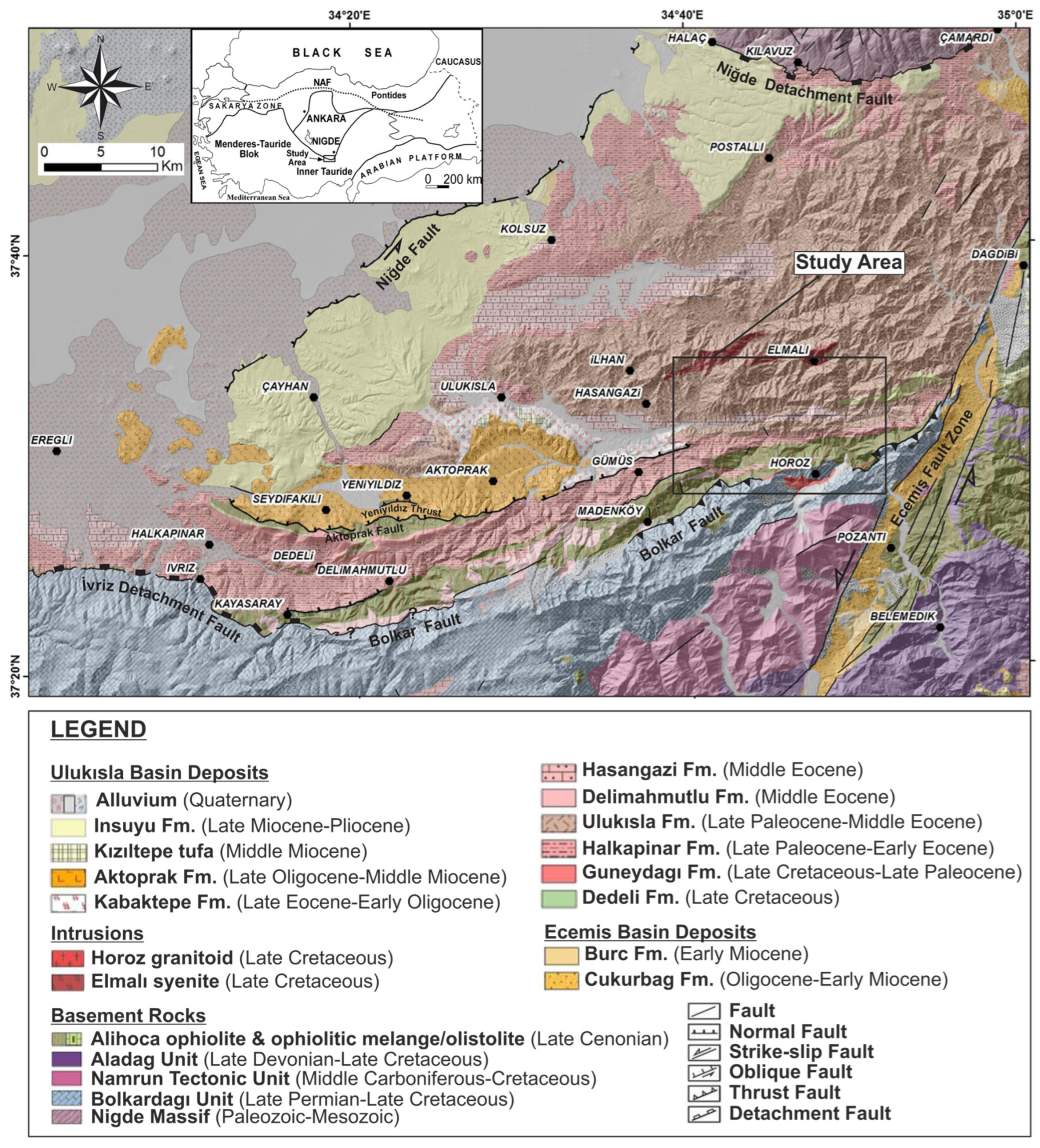

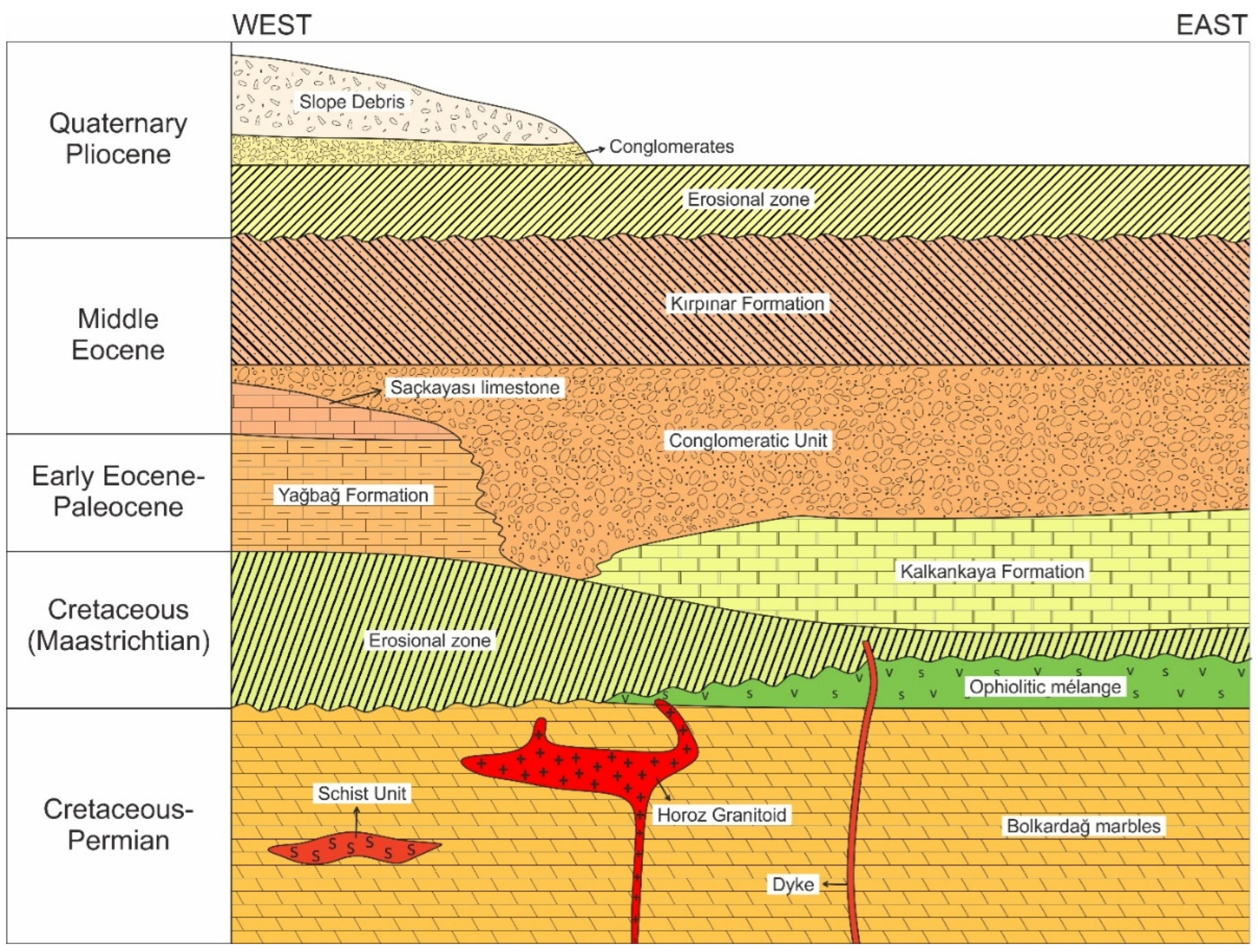
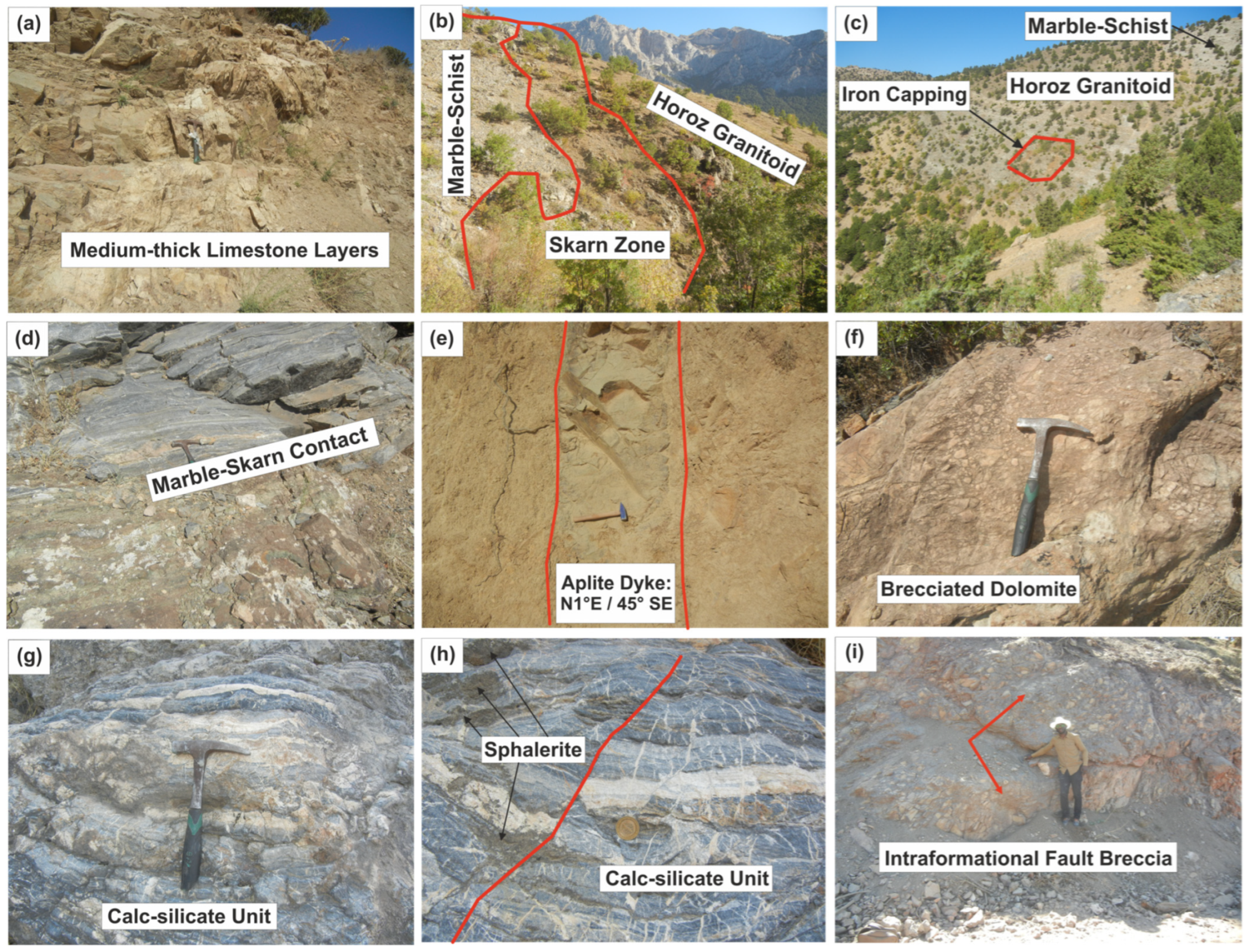


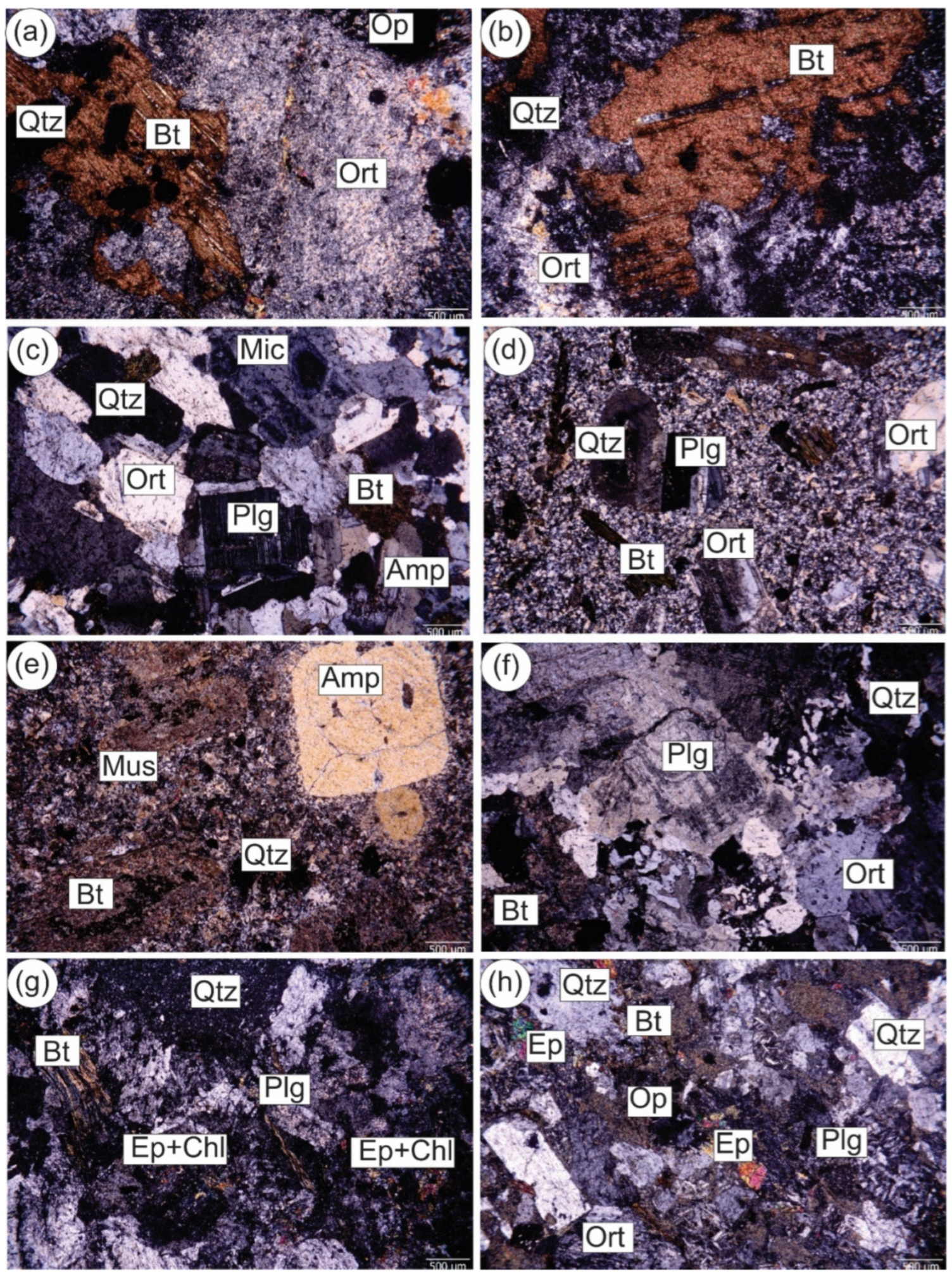
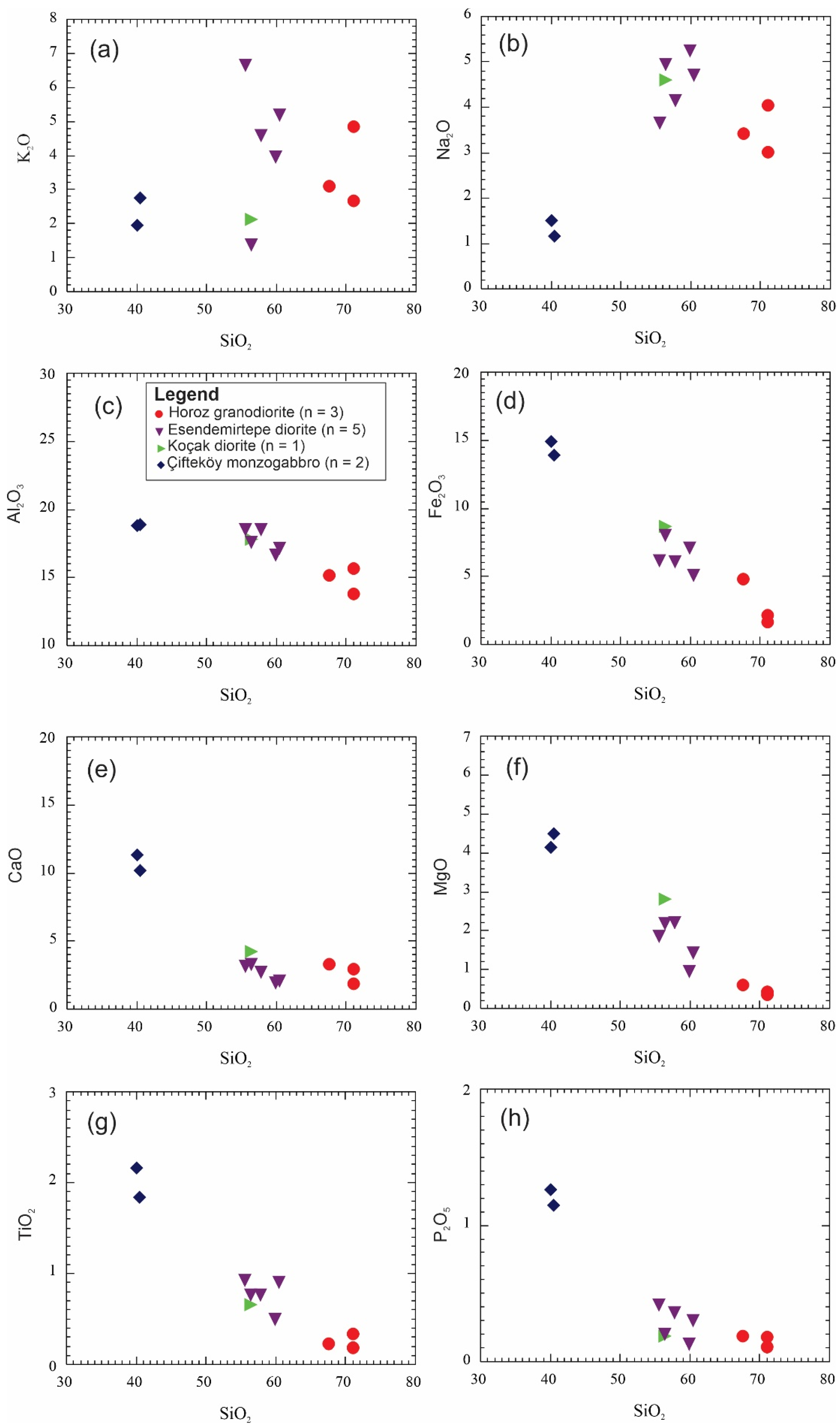
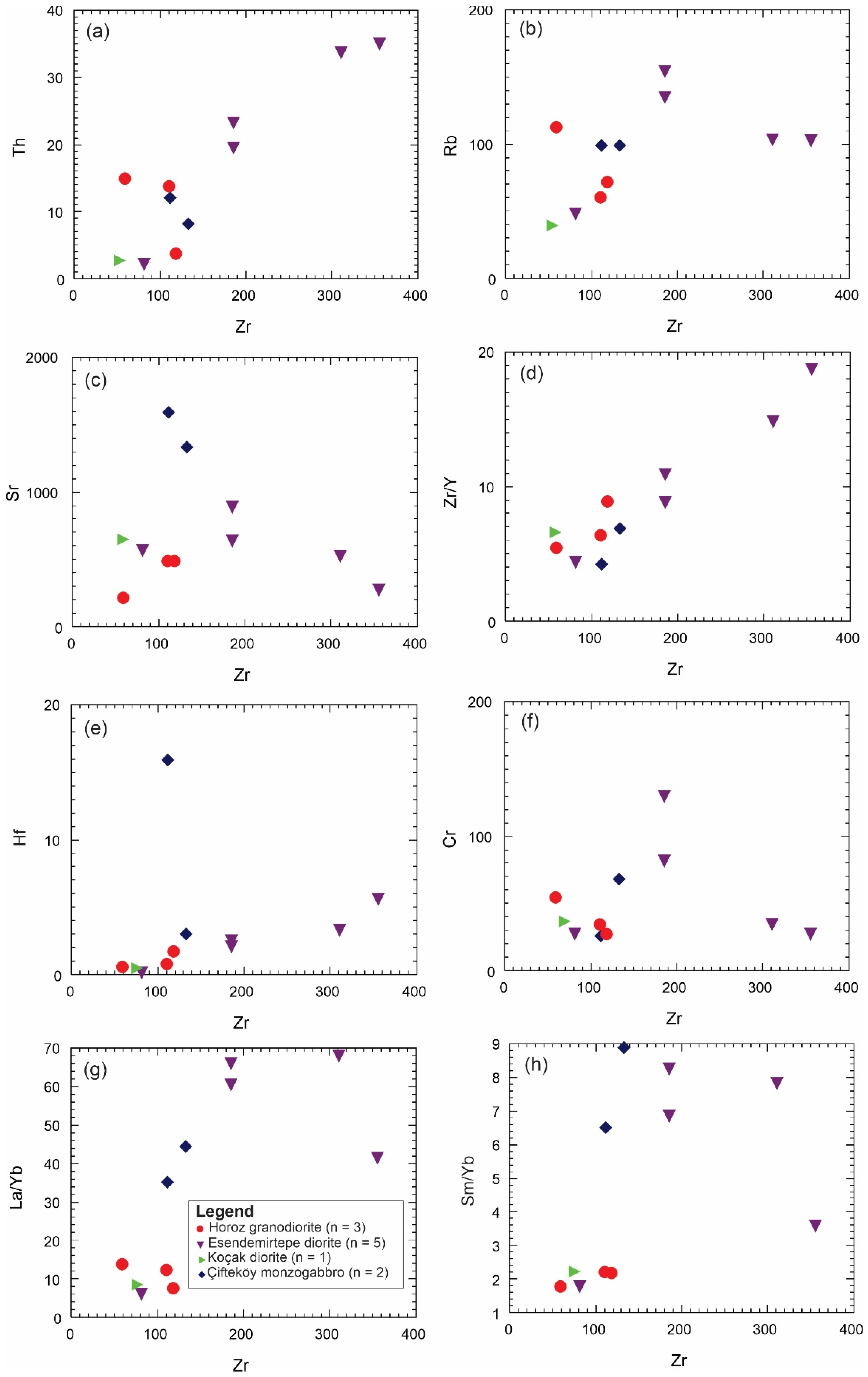
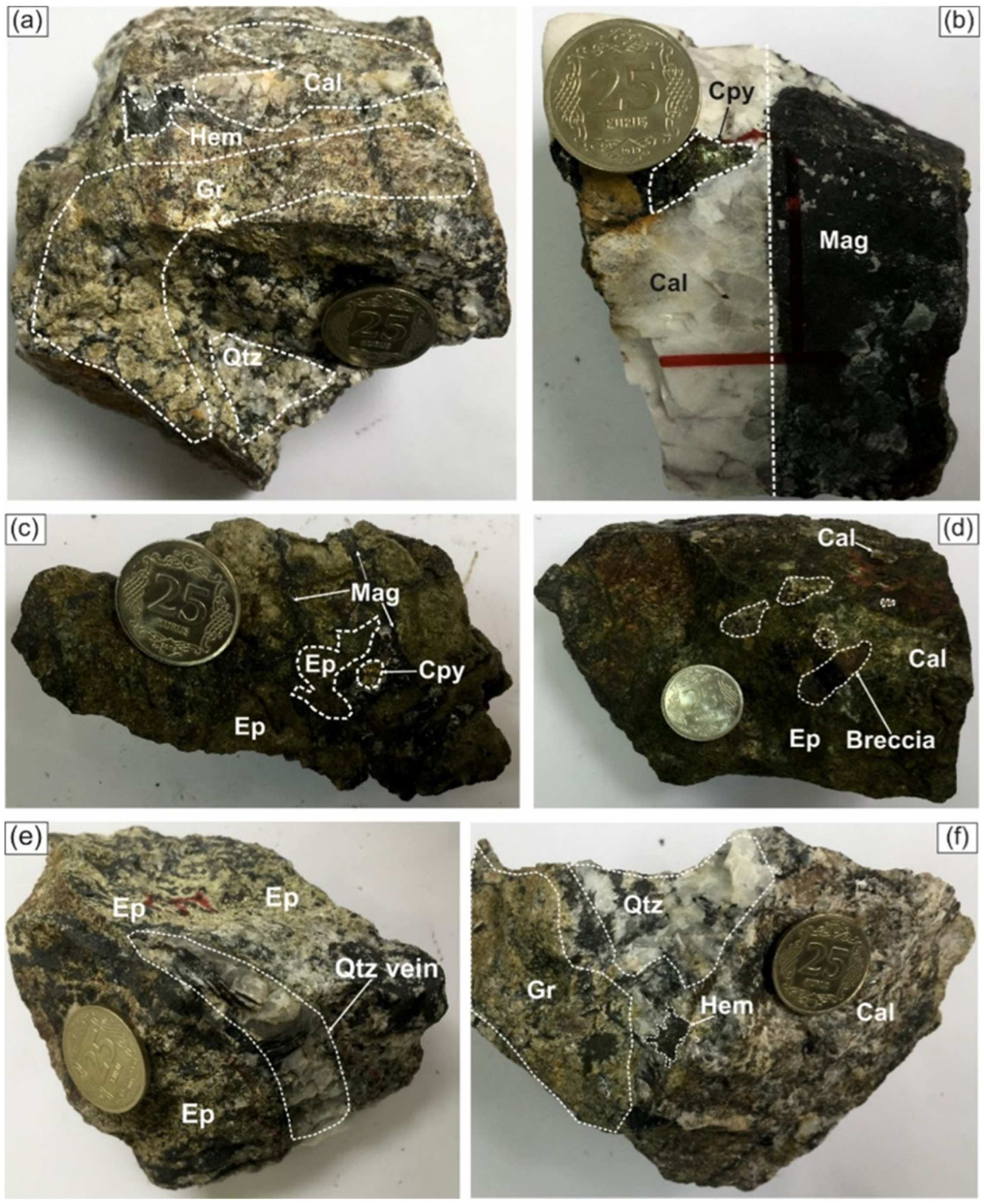
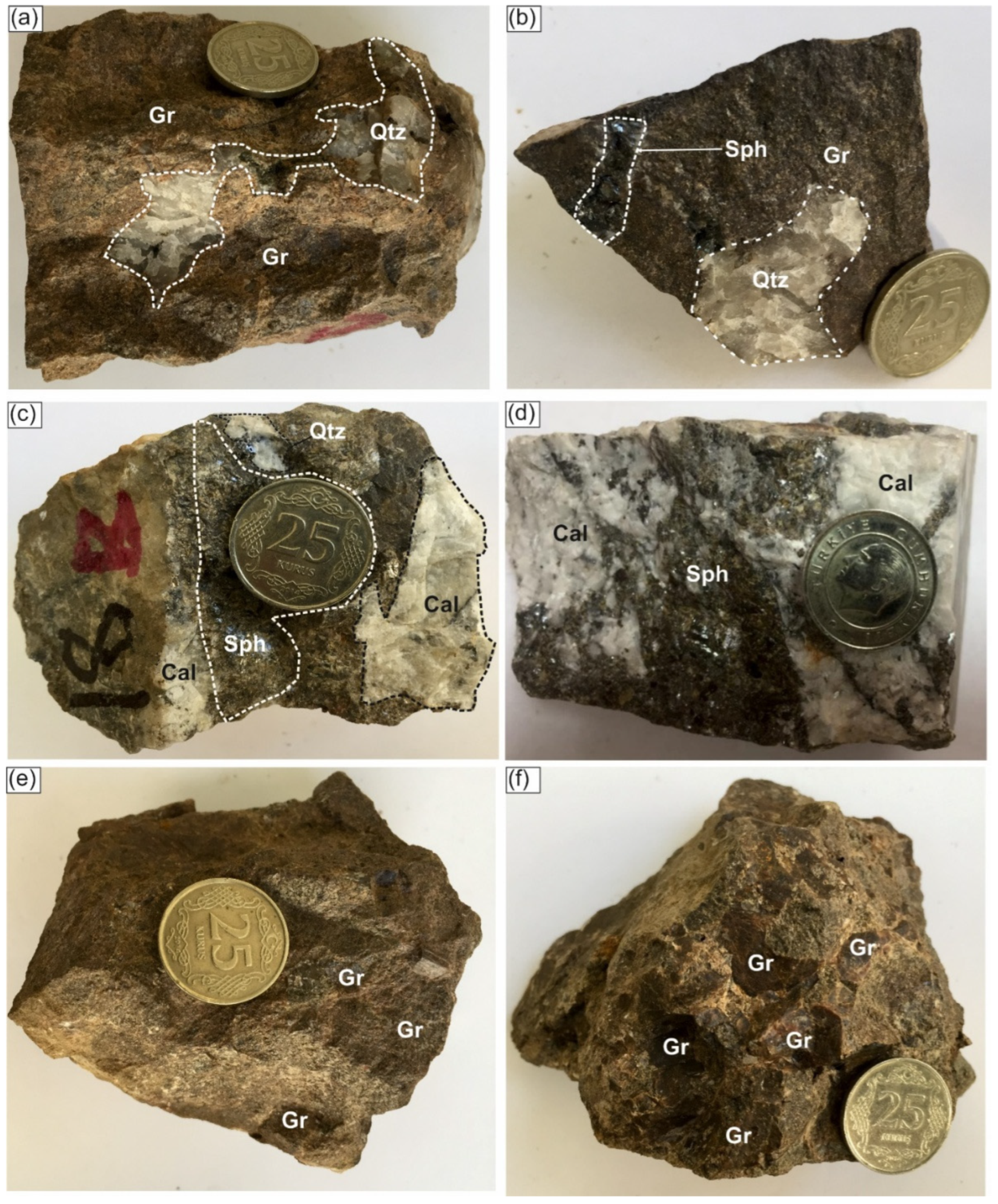
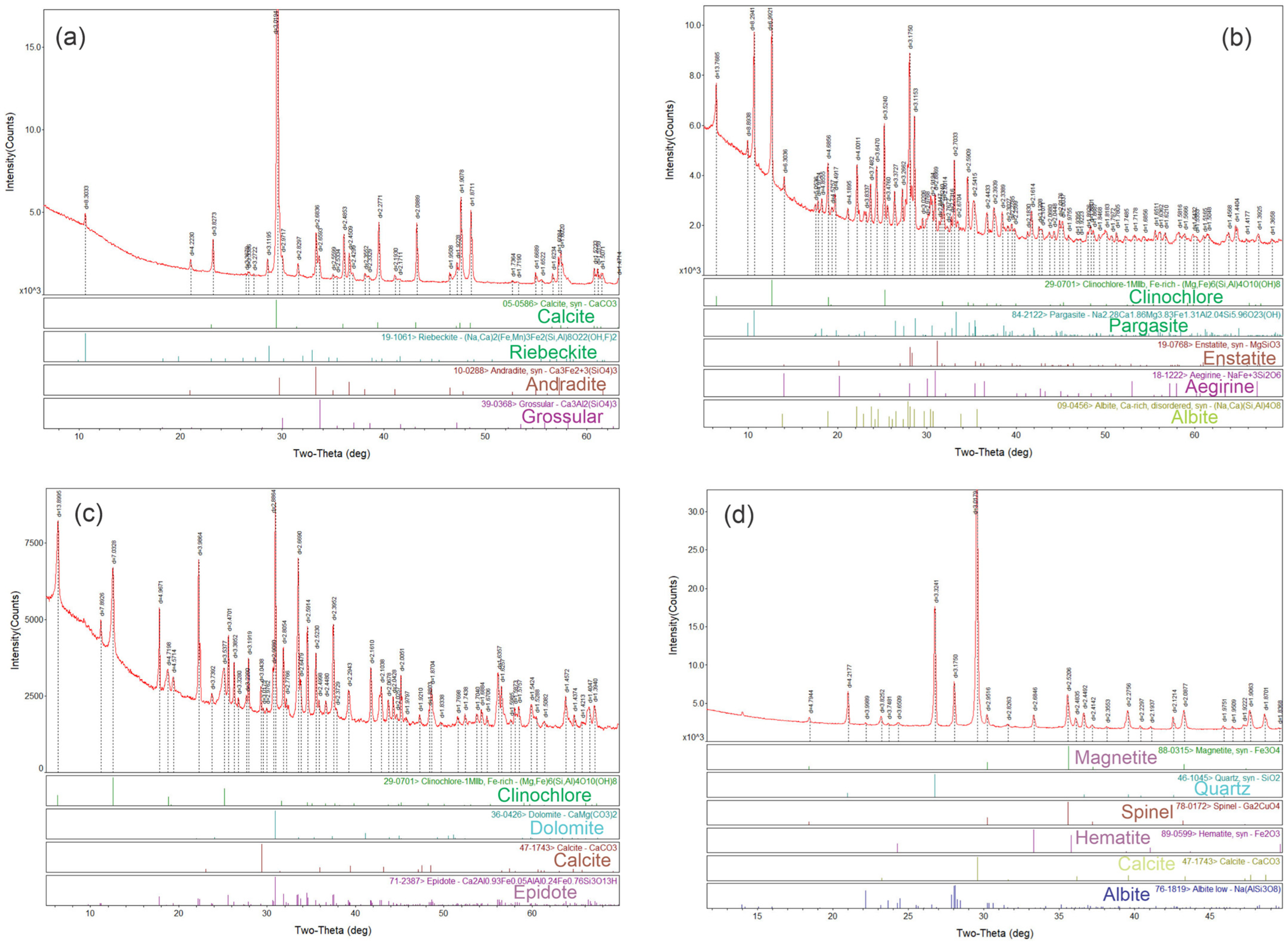
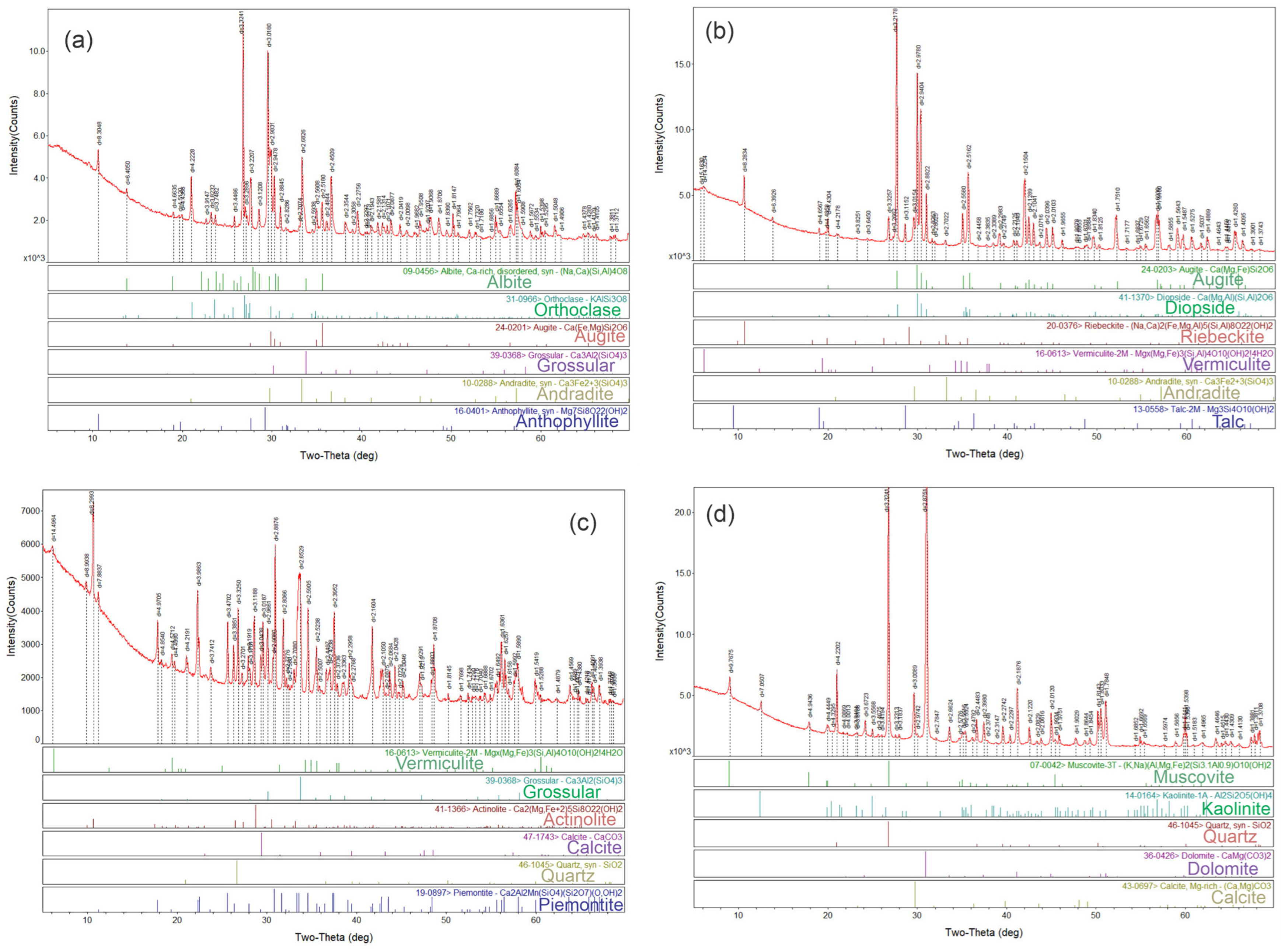
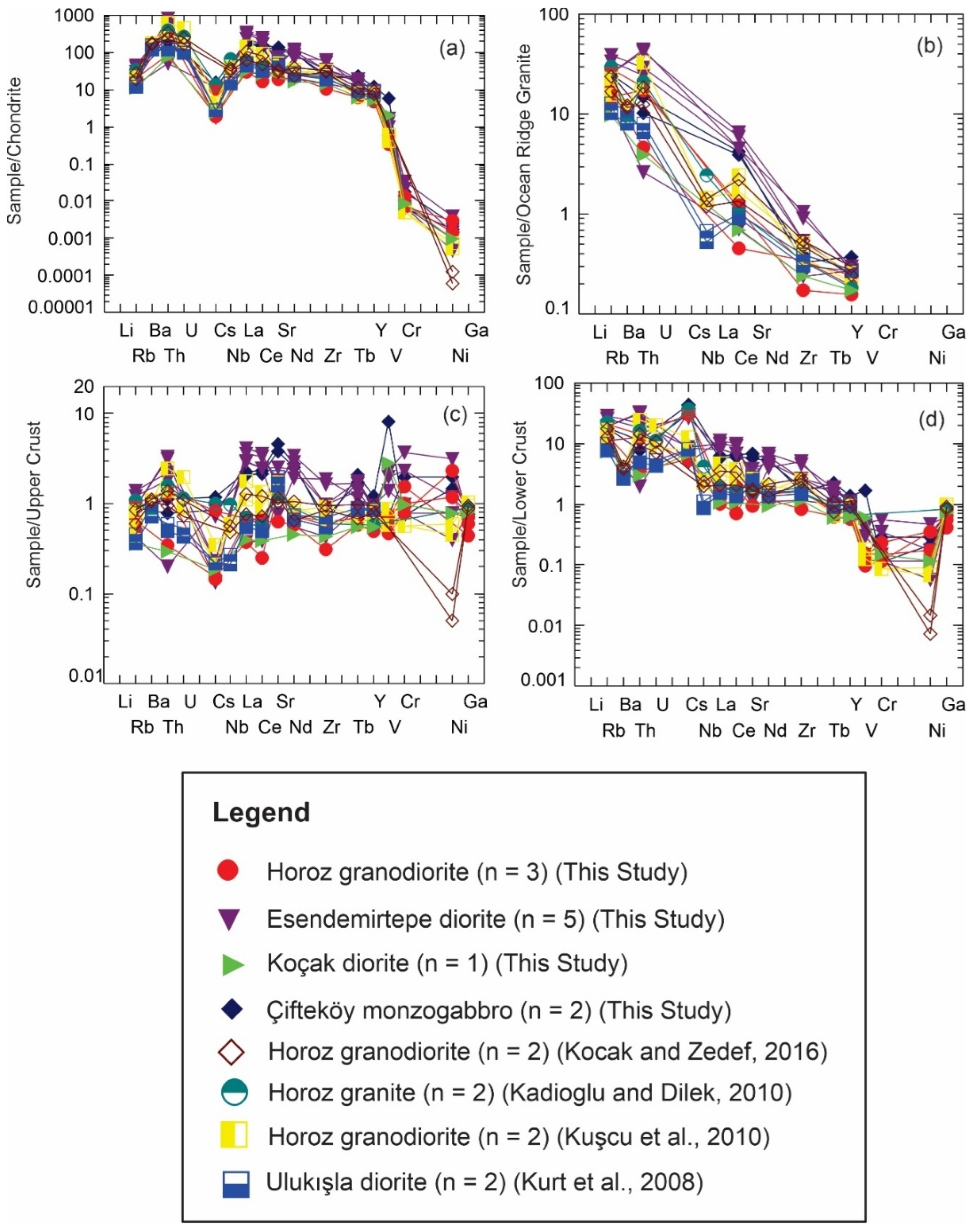
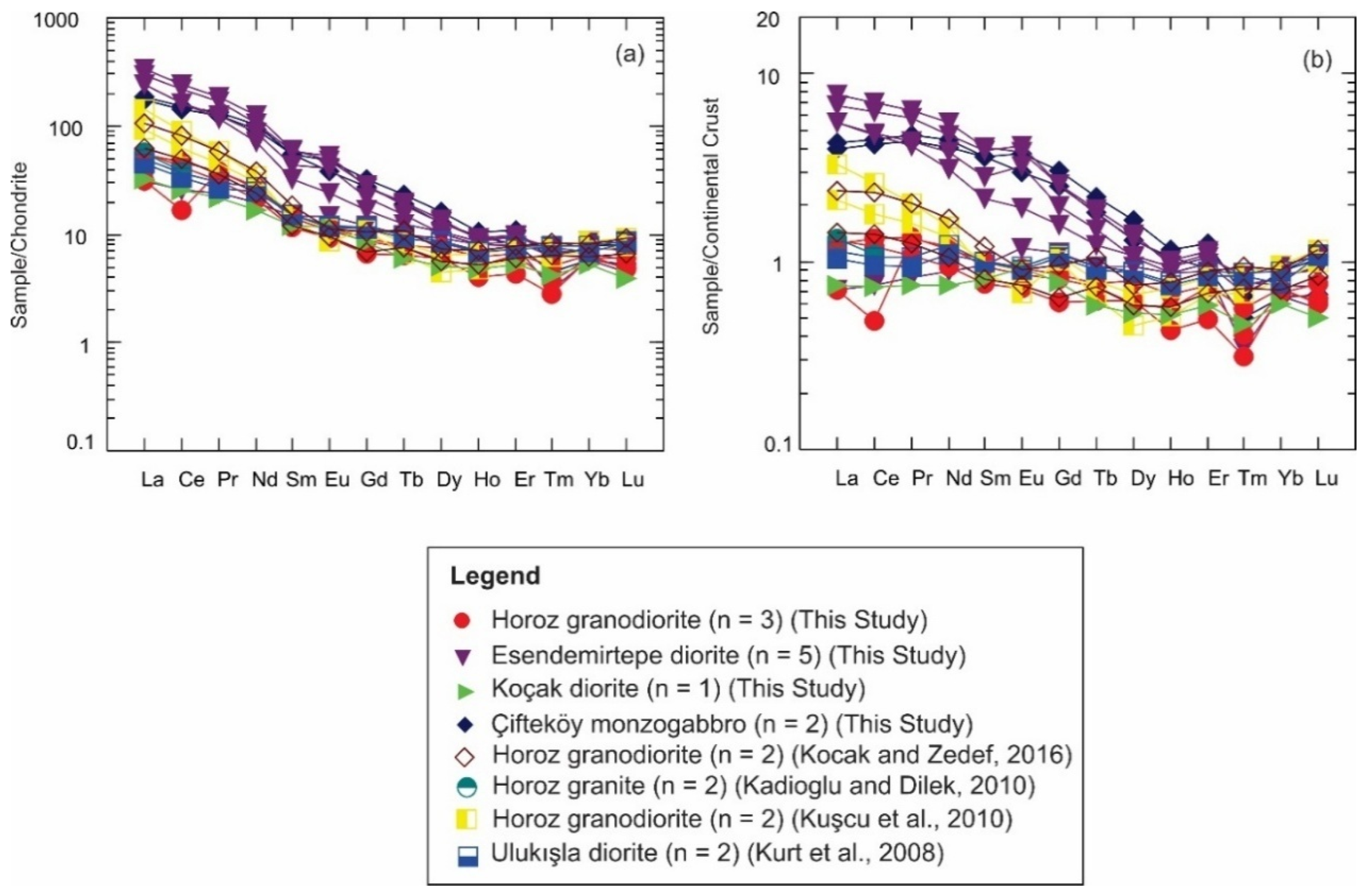
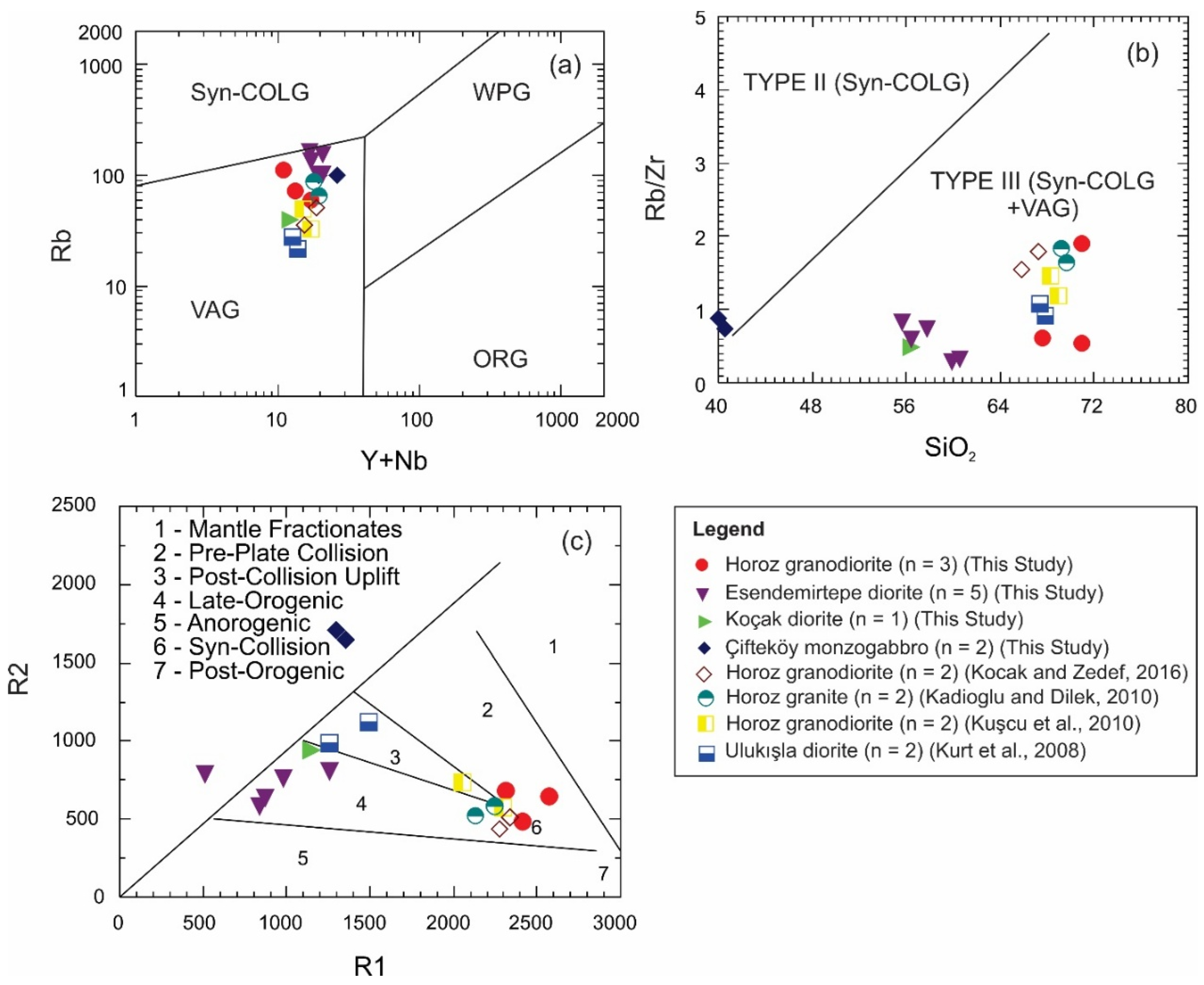
| Sample No. | C1 | C3 | H3B | H16 | H19 | KE1 | EM13 | EM10 | E4B | ED2A | ED2C |
|---|---|---|---|---|---|---|---|---|---|---|---|
| Rock Name | Çifteköy Monzogabbro | Horoz Granodiorite | Koçak Diorite | Esendemirtepe Diorite | |||||||
| Major elements (wt.%) | |||||||||||
| SiO2 | 40.5 | 40.0 | 71.0 | 67.6 | 71.2 | 56.4 | 59.9 | 56.4 | 60.5 | 57.8 | 55.6 |
| Al2O3 | 18.9 | 18.8 | 15.7 | 15.2 | 13.8 | 17.8 | 16.7 | 17.2 | 17.2 | 18.5 | 18.5 |
| Fe2O3 | 13.9 | 14.9 | 1.63 | 4.83 | 2.15 | 8.69 | 7.12 | 8.04 | 5.08 | 6.13 | 6.19 |
| CaO | 10.2 | 11.3 | 2.93 | 3.33 | 1.85 | 4.27 | 1.95 | 3.33 | 2.11 | 2.73 | 3.13 |
| MgO | 4.49 | 4.14 | 0.42 | 0.60 | 0.36 | 2.80 | 0.95 | 2.19 | 1.44 | 2.22 | 1.86 |
| Na2O | 1.71 | 1.50 | 4.05 | 3.42 | 3.02 | 4.61 | 5.24 | 4.95 | 4.71 | 4.16 | 3.66 |
| K2O | 2.75 | 1.96 | 2.68 | 3.11 | 4.85 | 2.13 | 3.96 | 1.38 | 5.18 | 4.58 | 6.66 |
| MnO | 0.07 | 0.07 | 0.02 | 0.02 | 0.01 | 0.05 | 0.06 | 0.02 | 0.04 | 0.09 | 0.09 |
| TiO2 | 1.84 | 2.16 | 0.33 | 0.29 | 0.18 | 0.66 | 0.50 | 0.76 | 0.90 | 0.77 | 0.93 |
| P2O5 | 1.15 | 1.26 | 0.18 | 0.19 | 0.11 | 0.19 | 0.13 | 0.20 | 0.30 | 0.36 | 0.42 |
| Cr2O3 | 0.01 | 0.00 | 0.01 | 0.00 | 0.01 | 0.01 | 0.00 | 0.00 | 0.01 | 0.02 | 0.01 |
| LOI | 3.50 | 2.29 | 0.84 | 1.15 | 2.30 | 2.03 | 2.95 | 3.82 | 1.83 | 1.90 | 1.95 |
| Total | 99.0 | 98.4 | 99.8 | 99.7 | 99.8 | 99.7 | 99.4 | 98.3 | 99.3 | 99.2 | 99.1 |
| Trace elements (ppm) | |||||||||||
| Cr | 68.4 | 26.0 | 34.2 | 27.4 | 54.8 | 34.2 | 27.4 | 27.4 | 34.2 | 130 | 82.1 |
| Ni | 39.3 | 29.8 | 23.6 | 47.1 | 7.86 | 15.7 | 15.7 | 7.86 | 15.7 | 62.8 | 23.6 |
| Pb | 27.9 | 11.8 | 10.2 | 9.29 | ND | ND | 27.9 | 9.29 | 9.29 | 9.29 | 9.29 |
| Cu | 7.99 | 8.79 | 7.99 | 7.99 | 24.0 | 104 | 31.9 | 39.9 | 31.9 | 16.0 | 7.99 |
| Mn | 531 | 568 | 157 | 164 | 106 | 393 | 475 | 147 | 280 | 702 | 678 |
| V | 448 | 482 | 44.8 | 28.0 | 39.2 | 168 | 33.6 | 140 | 84.0 | 140 | 118 |
| Ga | 13.1 | 13.0 | 10.1 | 11.8 | 7.50 | 13.5 | 11.8 | 13.0 | 12.8 | 11.1 | 12.9 |
| Rb | 99.1 | 79.3 | 60.0 | 71.8 | 113 | 39.5 | 102 | 48.3 | 104 | 135 | 154 |
| Pd | 0.02 | 0.07 | 0.08 | 0.01 | 0.01 | 0.02 | 0.02 | 0.06 | 0.02 | 0.02 | 0.02 |
| Rh | 0.24 | 0.24 | 0.01 | 0.01 | ND | 0.02 | ND | 0.01 | ND | 0.04 | 0.01 |
| In | 0.00 | 0.00 | 0.00 | 0.00 | 0.00 | 0.02 | 0.02 | 0.08 | 0.00 | 0.00 | 0.05 |
| Cs | 3.17 | 4.30 | 0.53 | 0.56 | 3.02 | 0.68 | 0.84 | 3.21 | 0.49 | 2.68 | 0.86 |
| Tl | 0.47 | 0.42 | 0.07 | 0.22 | 0.26 | 0.16 | 0.69 | 0.23 | 0.45 | 0.78 | 0.74 |
| Zr | 133 | 112 | 111 | 118 | 59.2 | 81.4 | 355 | 81.4 | 311 | 185 | 185 |
| Y | 19.4 | 26.4 | 17.3 | 13.3 | 10.9 | 12.1 | 19.0 | 18.7 | 21.0 | 17.0 | 21.0 |
| Th | 8.26 | 12.0 | 13.7 | 9.72 | 14.9 | 3.14 | 35.0 | 2.12 | 33.7 | 19.6 | 23.3 |
| U | 1.39 | 2.16 | 3.66 | 3.35 | 3.10 | 0.80 | 6.32 | 0.31 | 3.62 | 1.86 | 2.65 |
| Hf | 3.05 | 15.9 | 0.79 | 1.73 | 0.56 | 0.21 | 5.61 | 0.17 | 3.28 | 2.06 | 2.53 |
| Nb | 8.50 | 4.30 | 7.70 | 10.5 | 6.60 | 10.9 | 5.80 | 4.86 | 8.30 | 5.95 | 8.70 |
| Rare earth elements (ppm) | |||||||||||
| La | 63.1 | 68.4 | 19.9 | 113 | 20.7 | 11.9 | 88.0 | 11.4 | 123 | 87.2 | 109 |
| Ce | 138 | 148 | 44.0 | 160 | 39.8 | 24.5 | 157 | 24.9 | 232 | 158 | 209 |
| Pr | 17.1 | 18.5 | 5.25 | 5.18 | 4.22 | 2.93 | 16.0 | 3.24 | 25.0 | 17.2 | 22.8 |
| Nd | 65.3 | 72.0 | 18.6 | 19.4 | 15.2 | 11.9 | 50.1 | 14.2 | 87.8 | 61.4 | 75.7 |
| Sm | 12.6 | 12.6 | 3.54 | 3.30 | 2.69 | 2.81 | 7.57 | 3.38 | 14.15 | 9.88 | 13.6 |
| Eu | 3.29 | 4.11 | 1.01 | 0.95 | 0.80 | 1.01 | 2.11 | 1.29 | 4.22 | 3.55 | 4.58 |
| Gd | 8.36 | 9.99 | 2.80 | 2.65 | 2.01 | 2.57 | 5.17 | 3.70 | 8.52 | 6.56 | 8.42 |
| Tb | 1.09 | 1.33 | 0.46 | 0.44 | 0.37 | 0.35 | 0.73 | 0.57 | 1.07 | 0.89 | 1.13 |
| Dy | 4.85 | 6.12 | 2.91 | 2.21 | 2.31 | 1.97 | 3.97 | 3.50 | 4.88 | 3.92 | 5.18 |
| Ho | 0.82 | 0.91 | 0.52 | 0.44 | 0.34 | 0.41 | 0.74 | 0.68 | 0.79 | 0.68 | 0.75 |
| Er | 2.03 | 2.75 | 1.65 | 1.61 | 1.09 | 1.30 | 2.34 | 2.17 | 2.49 | 1.95 | 2.39 |
| Tm | 0.16 | 0.21 | 0.18 | 0.13 | 0.10 | 0.15 | 0.27 | 0.22 | 0.24 | 0.11 | 0.25 |
| Yb | 1.42 | 1.94 | 1.60 | 1.51 | 1.50 | 1.32 | 2.12 | 1.90 | 1.81 | 1.44 | 1.65 |
| Lu | 0.20 | 0.31 | 0.18 | 0.23 | 0.19 | 0.15 | 0.32 | 0.27 | 0.28 | 0.17 | 0.22 |
| ∑REE | 318 | 347 | 103 | 311 | 91 | 63 | 336 | 71 | 506 | 353 | 455 |
| Eu/Eu* | 0.98 | 1.12 | 0.98 | 0.98 | 1.05 | 1.15 | 1.03 | 1.12 | 1.17 | 1.35 | 1.31 |
| (La/Yb)N | 27.4 | 21.7 | 7.66 | 46.1 | 8.50 | 5.55 | 25.6 | 3.70 | 41.9 | 37.3 | 40.7 |
| (Gd/Yb)N | 4.32 | 3.78 | 1.28 | 1.29 | 0.98 | 1.43 | 1.79 | 1.43 | 3.45 | 3.34 | 3.74 |
| (Ce/Yb)N | 23.2 | 18.2 | 6.55 | 25.2 | 6.32 | 4.42 | 17.6 | 3.12 | 30.5 | 26.1 | 30.2 |
Disclaimer/Publisher’s Note: The statements, opinions and data contained in all publications are solely those of the individual author(s) and contributor(s) and not of MDPI and/or the editor(s). MDPI and/or the editor(s) disclaim responsibility for any injury to people or property resulting from any ideas, methods, instructions or products referred to in the content. |
© 2025 by the authors. Licensee MDPI, Basel, Switzerland. This article is an open access article distributed under the terms and conditions of the Creative Commons Attribution (CC BY) license (https://creativecommons.org/licenses/by/4.0/).
Share and Cite
Sunkari, E.D.; Lermi, A. Geological, Mineralogical, Geochemical, and Petrogenetic Characteristics of Plutonic Rocks in Çiftehan (Ulukışla-Niğde) Area, South-Central Türkiye: Implication for Genetic Link with Fe-Zn Skarn Mineralization. Minerals 2025, 15, 578. https://doi.org/10.3390/min15060578
Sunkari ED, Lermi A. Geological, Mineralogical, Geochemical, and Petrogenetic Characteristics of Plutonic Rocks in Çiftehan (Ulukışla-Niğde) Area, South-Central Türkiye: Implication for Genetic Link with Fe-Zn Skarn Mineralization. Minerals. 2025; 15(6):578. https://doi.org/10.3390/min15060578
Chicago/Turabian StyleSunkari, Emmanuel Daanoba, and Abdurrahman Lermi. 2025. "Geological, Mineralogical, Geochemical, and Petrogenetic Characteristics of Plutonic Rocks in Çiftehan (Ulukışla-Niğde) Area, South-Central Türkiye: Implication for Genetic Link with Fe-Zn Skarn Mineralization" Minerals 15, no. 6: 578. https://doi.org/10.3390/min15060578
APA StyleSunkari, E. D., & Lermi, A. (2025). Geological, Mineralogical, Geochemical, and Petrogenetic Characteristics of Plutonic Rocks in Çiftehan (Ulukışla-Niğde) Area, South-Central Türkiye: Implication for Genetic Link with Fe-Zn Skarn Mineralization. Minerals, 15(6), 578. https://doi.org/10.3390/min15060578







